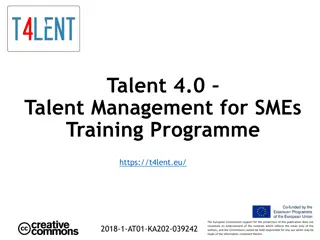Teachers as Talent Scouts: Observing and Developing Student Potential
Explore the concept of teachers as talent scouts, focusing on identifying and nurturing students' potential and talents. Delve into topics such as academic persistence, mindset, and grit, emphasizing the importance of non-cognitive skills in academic success. Learn how academic perseverance plays a crucial role in students' achievements and discover practical strategies for implementing these principles in educational settings.
Download Presentation

Please find below an Image/Link to download the presentation.
The content on the website is provided AS IS for your information and personal use only. It may not be sold, licensed, or shared on other websites without obtaining consent from the author.If you encounter any issues during the download, it is possible that the publisher has removed the file from their server.
You are allowed to download the files provided on this website for personal or commercial use, subject to the condition that they are used lawfully. All files are the property of their respective owners.
The content on the website is provided AS IS for your information and personal use only. It may not be sold, licensed, or shared on other websites without obtaining consent from the author.
E N D
Presentation Transcript
Teachers As Talent Scouts Introduction to TOPS: Teachers Observation of Potential in Students Finding and Developing Students Talents October 28, 2015
Plan for Today 1:45-2:30 Dr. Gutshall on Academic Persistence 2:30 2:45 Using the Teacher Observation of Potential in Students: Marie Sanders and selected teachers from Angel Oak 2:45- 3:30 Practice with TOPS
GRIT and Talent Development C. Anne Gutshall October 28, 2015
Recall.Carol Dweck- Stanford University What we believe about our abilities influences our motivation We all have implicit beliefs about our ability (growth, fixed). Commonly referred to mindset.
It turns out that Academic Mindset Is part of a larger framework called the Non-Cognitive Factors or behaviors, skills, attitudes, and strategies that are crucial to academic performance in their classes (Farrington et. al, 2012)
Taken from USDE: Promoting Grit, Tenacity and Perseverance (2013)
According to the US Department of Education 2013 draft report The test score accountability movement has pushed aside many of these so-called non-cognitive or soft skills, and they belong back on the front burner. John Easton, Director of the Department of Education Institute of Educational Sciences (Easton, April 14, 2012, p. 19)
Today we will focus on ACADEMIC PESEVERANCE or GRIT Short Grit Scale
GRIT Angela Duckworth and Martin Seligman The degree to which students stay focused on long term goals despite obstacles duckworth
In broader terms, researchers imagine GRIT to be . Perseverance to accomplish long-term or higher-order goals in the face of challenges and setbacks, engaging the student s psychological resources, such as their academic mindsets, effortful control, and strategies and tactics.
3 ways to grow GRIT in schools 1. Academic Mindsets- Compelling evidence suggests that mindsets can have a powerful impact on academic performance in general, and in particular on how students behave and perform in the face of challenge. A core mindset that supports perseverance is called the growth mindset knowing My ability and competence grow with my effort.
2. Effortful Control Successful students marshal willpower and regulate their attention during less than fascinating tasks and in the face of distractions. While this can seem austere or no fun, research shows that students stronger in these skills are happier and better able to handle stress
What does a Marshmallow have to do with Effortful Control? The marshmallow experiment and delay of gratification marshmallow experiment
3. Help Learners Develop Strategies and Tactics GRIT is grown in learners that have actionable skills for taking responsibility and initiative and for being productive under conditions of uncertainty for example, defining tasks, planning, monitoring, changing course of action, and dealing with specific obstacles.
Other Ideas to Grow GRIT -Teach students about GRIT...read stories, show videos of kids and people who have persisted in the face of obstacles. - Model and explicitly teach that mistakes are part of learning. Make sure your classroom is a safe zone for making mistakes -Encourage and celebrate persistence in the face of challenges
Grow GRIT (continued) -In order to persist and learn from mistakes, students need time to delve into learning ..give ample time and sufficiently challenging tasks -Help students to plan for obstacles and articulate strategies. -When learners present a project, or interview a speaker, have a What was the biggest obstacle and how did you overcome it question or What did you do when you wanted to quit?
Want to Read More? How Children Succeed: Grit, Curiosity, and the Hidden Power of Character by Paul Tough Promoting Grit, Tenacity, and Perseverance: Critical Factors for Success in the 21st Century (PDF) by the U.S. Department of Education's Office of Educational Technology The Marshmallow Test: Why Self-Control is the Engine of Success by Walter Mischel
Stop and Consider? Is your classroom setting a sprint or a marathon? What might an optimal learning setting for growing GRIT look like?
So what does a GRITTY kid look like???? Was Cain a kid with GRIT?
U-STARS~PLUSThe Big Star Teacher s Systematic Observations
To recognize potential in students Know what to look for. Respond in ways that support high- end learning. Recognize that children are at their best in an emotionally supportive classroom.























